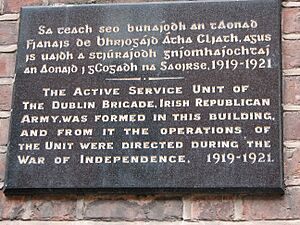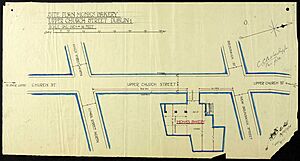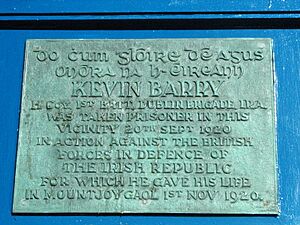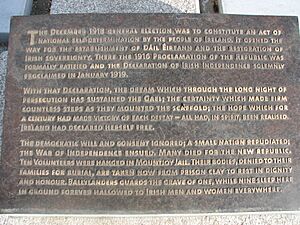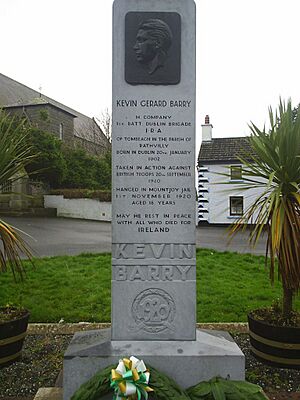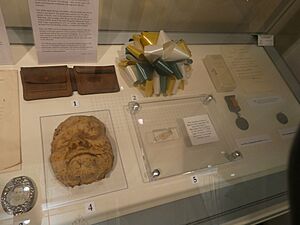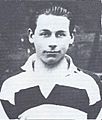Kevin Barry facts for kids
Quick facts for kids
Kevin Barry
|
|
|---|---|
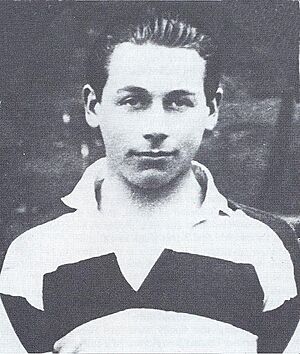
Kevin Barry in the rugby jersey of Belvedere College, Dublin
|
|
| Born |
Kevin Gerard Barry
20 January 1902 Fleet Street, Dublin, Ireland
|
| Died | 1 November 1920 (aged 18) Mountjoy Jail, Dublin, Ireland
|
| Cause of death | Execution by hanging |
| Nationality | Irish |
| Occupation | Medical student |
| Known for | Executed Irish Republican Army volunteer |
| Military career | |
| Allegiance | |
| Service/ |
North Dublin |
| Years of service | 1917–1920 |
| Battles/wars | Irish War of Independence |
Kevin Gerard Barry (born January 20, 1902 – died November 1, 1920) was a young Irish Republican Army (IRA) soldier. He was executed by the British Government during the Irish War of Independence. He was sentenced to death after being involved in an event where a British Army supply truck was attacked, and three British soldiers died.
His execution caused strong feelings among Irish people who wanted independence, especially because he was so young. It happened just seven days after Terence MacSwiney, the republican Lord Mayor of Cork, died from a hunger strike. This made public anger even stronger. Many people around the world, including officials from the U.S. and the Vatican, tried to save him. Kevin Barry's death, along with MacSwiney's, led to more fighting in the Irish War of Independence. Kevin Barry became known as an Irish republican hero.
Contents
Kevin Barry's Early Life
Kevin Barry was born in Dublin on January 20, 1902. His parents were Thomas and Mary Barry. He was the fourth of seven children. His father ran a successful dairy business in Dublin. Sadly, his father died when Kevin was only six years old.
After his father's death, Kevin's mother moved the family to their farm in County Carlow. They still kept their house in Dublin. As a child, Kevin went to a local school in Rathvilly. In 1915, he moved back to Dublin for school. He attended St Mary's College for a while.
During this time, important events were happening in Ireland, like the Easter Rising in April 1916. These events likely had an impact on young Kevin.
School Days at Belvedere College
When St Mary's College closed, Kevin Barry moved to Belvedere College. This was a Jesuit school in Dublin. He was a good athlete there. He played on the junior rugby team that won a championship. He also earned a spot on the senior rugby team.
In 1918, he became the secretary of the school's hurling club. Hurling is a traditional Irish sport. Kevin was one of the most excited players in the club.
In 1919, his last year at Belvedere, Kevin wrote an essay. He supported the Dublin Lockout, which was a big workers' strike. He wrote about the power of workers and leaders like James Larkin and James Connolly. Even though he was a good student, his grades sometimes varied. After graduating, he won a scholarship from Dublin Corporation. This allowed him to study medicine at University College Dublin (UCD).
Becoming a Medical Student
Kevin Barry started studying medicine at UCD in October 1919. He was a student there for about a year. His closest friend at UCD was Gerry MacAleer. Another friend was Frank Flood, who was studying engineering.
Kevin's medical studies were important, but he also enjoyed other things like dancing and going to the cinema. Because of these activities, he only attended about three-quarters of his medical lectures. Another big part of his life was being a member of the Irish Volunteers. Several UCD medical students were also in the Volunteers.
Even though Kevin was very involved in the Volunteers, he kept it a secret. His closest friend, Gerry McAleer, did not know about this part of his life for a long time.
Joining the Volunteers
In October 1917, when Kevin was 15, he joined the Irish Volunteers. He was part of Company C, 1st Battalion of the Dublin Brigade. Later, he was moved to a new group called Company H. When he was on vacation from school, he also served with a group in County Carlow.
The next year, at age 16, he joined a secret group called the Clarke Luby Club of the Irish Republican Brotherhood (IRB). This group was led by Michael Collins.
Kevin was a Volunteer for almost three years. However, he didn't have much experience in actual fighting before a specific event called the Monk's Bakery ambush. Most Volunteers in Dublin spent their time training. Few of them saw real action or heard shots fired.
The Monk's Bakery Ambush
In September 1920, a Volunteer leader named Captain Seamus Kavanagh learned something important. He found out that a British army truck, guarded by soldiers, went to Monk's Bakery twice a week to pick up bread.
Captain Kavanagh got permission to plan an ambush. He chose men from his company to take part. Kevin Barry was a member of a different company, but when he heard about the plan, he asked if he could join.
On the morning of September 20, 1920, Kevin Barry went to Mass. Afterward, he met with other IRA volunteers on Bolton Street in Dublin.
The ambush did not go as planned. Kevin Barry's comrades left the scene, and he was left behind. British soldiers then saw him and arrested him. One of the soldiers, Private Harold Washington, was killed. Two other soldiers, Privates Marshall Whitehead and Thomas Humphries, were badly hurt and later died.
Trial and Execution
Kevin Barry was charged in connection with the death of Private Marshall Whitehead. He was sentenced to death. His execution took place at Mountjoy Prison in Dublin on November 1, 1920.
On October 14, 2001, the remains of ten Irish republicans, including Kevin Barry, were given a state funeral. They were moved from Mountjoy Prison and reburied at Glasnevin Cemetery in Dublin.
Remembering Kevin Barry
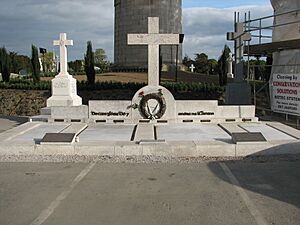
Kevin Barry's nephew, Donal O'Donovan, wrote a book about his life called Kevin Barry and his Time. A shorter book about him was written by Sean Cronin in 1965.
Kevin Barry is also remembered in a very famous song about his time in prison and his execution. This song was written soon after he died and is still sung today. The music for the song "Kevin Barry" comes from an old sea-shanty called "Rolling Home."
Kevin Barry's Legacy
In 1930, Irish immigrants in Hartford, Connecticut, started a hurling club and named it after Kevin Barry. This club later disappeared but was brought back in 2011.
A special stamp was released in 1970 to mark 50 years since Kevin Barry's death. Student groups at University College Dublin and University of Galway are named after him. There is also a GAA club (Gaelic Athletic Association) in County Tyrone called Derrylaughan Kevin Barry's.
In 1934, a large stained-glass window honoring Kevin Barry was put in at University College Dublin. It was designed by Richard King. In 2007, when UCD moved to a new campus, money was raised to move and restore this important window.
Kevin Barry's execution is mentioned in the folk song "Rifles of the I.R.A." by Dominic Behan. The ballad "Kevin Barry" has been sung by many famous artists, including Paul Robeson and Leonard Cohen. In Dublin, two blocks of flats are named after him at the place where he was captured.
Images for kids


